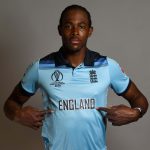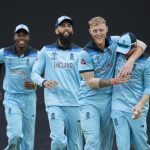The hidden side of England’s cricketing victory
England’s World Cup triumph was celebrated as a victory of inclusion with a team made up of cricketers from all over the world, but the number of black players in the country is dwindling.
Author:
16 September 2019

There’s a buzz in Brixton unlike any other in London. You feel it as you climb the stairs from the underground station, your steps beginning to sync with the busking drummer above. You come up for air, as you’re compelled towards Electric Avenue where Rastas take it higher in clouds of their own making. The smell from their joints mingles with those emanating from market stovetops.
The stream takes you down Cold Harbour Lane and around Atlantic Road, names that pay homage to this area’s link to the HMT Empire Windrush that docked in the cold harbour of Tilbury on 22 June 1948, after sailing across the Atlantic Ocean and before depositing 802 migrants from the Caribbean. They arrived searching for a better life in exchange for their labour, which would help rebuild the bombed-out boroughs of post-war Britain. Over the next 23 years, thousands more were ferried across the icy seas as part of the so-called Windrush Generation.
Related article:
They arrived on this rain-soaked rock in the shivering north Atlantic to lay down the bricks and mortar of houses, pubs and factories which their black skins denied them access to and made them targets for discrimination and hostility. Notions of a fresh start in a new world were quickly squashed by snarling natives and scant opportunities.
“There really wasn’t much else to get excited about,” said Dean Wilson, chief cricket correspondent for the Daily Mirror newspaper, whose Barbadian father settled in London and instilled in him a love for the game from a young age. “Cricket served as a crutch of sorts. There were not many other avenues to immerse oneself in and proudly show off one’s Caribbean heritage. Apart from music and food, cricket tied you to your cultural roots. Out on the pitch, a batter or bowler could rise above his station and challenge on a relatively equal playing field.”
Three years before the publication of his seminal book, Beyond a Boundary, Marxist historian and intellectual CLR James led a successful campaign to instil Frank Worrell as the first full-time black captain of the West Indies in 1960. A 2-1 Test series defeat in Australia was followed by a 5-0 home win over India in 1962 and a 3-1 win away in England in 1963. With swashbuckling players like Garfield Sobers, Rohan Kanhai and Lance Gibbs, Worrell’s team ignited the imaginations of their compatriots a world away.
Birth of a dynasty
But inconsistencies still plagued the team labelled the Calypso Cricketers, a term that invoked a stereotype of flamboyance underpinned by mental ineptitude. After Worrell’s resignation, Sobers failed to translate his mercurial genius into sustained success as captain before Kanhai won as many matches as he lost as skipper. Then Clive Lloyd took over and changed cricketing history.
Under Lloyd’s professorial guidance, the West Indies established a dynasty. There were two World Cup triumphs – in 1975 and 1979 – and an unmatched run of 29 consecutive Test series without defeat from 1980 to 1995. England’s Tony Greig was made to grovel in 1976. Over 10 Tests in 1984 and 1986, England were “blackwashed”. It was only when Hansie Cronje’s Proteas trounced Brian Lara’s team 5-0 in 1999 that the former kings of cricket officially lost their superpower status.
Cricket may present itself as a sport impervious to time, but every match has its conclusion. And when Viv Richards hit the winning runs or Michael Holding took the final wicket, Caribbeans living in Britain were forced to confront the unwelcoming world around them.
“Cricket was a means of escape and distraction,” said Gladstone Small, who played 70 matches for England having moved from Barbados with his family as a 14-year-old in 1975. “When I had a ball in my hand, everything else disappeared. I’d run in and bowl fast and the colour of my skin or the accent I spoke with became a non-issue. I made sure people judged me by the wickets I took.”
Small took enough wickets to attract the attention of Warwickshire and he soon climbed through the ranks of English cricket. He wasn’t the only player of Caribbean heritage making waves in his adopted homeland. Against the West Indies in Bridgetown in 1990, Small shared the strike bowling duties with Phil DeFreitas and Devon Malcolm – born in Dominica and Jamaica respectively – while Chris Lewis from Guyana was a few months away from playing the first of his 85 games for England.

No place for black cricketers
Between 1981 and 1990, England awarded nine black players Test caps. They carved out an enclave in the stuffily middle-class and mostly white world of English cricket. They inspired children from inner cities and impoverished hubs to pick up bats and balls. A new dawn began to peep over the horizon.
But it proved false. As Tim Wigmore wrote in The Telegraph newspaper, the number of black cricketers in the United Kingdom has dwindled dramatically. Jofra Archer – the Barbados-born head hunter who played an integral role in England’s Cricket World Cup victory in July, and who has devastated Australia over the Ashes – is only the third black player to make his Test debut for the Three Lions since 1999.
Across the men’s domestic game, the number of black cricketers has fallen by 75% in the past 25 years, from 33 in 1994 to nine in 2019. As Wigmore demonstrated, the dearth of black cricketers is prevalent in the women’s game, too, where there are just three players in the county game. A number of factors are to blame for this.
“There are more opportunities now and so our views have broadened over time,” Wilson explained. “I had more opportunities than my father and my kids have more opportunities than me. In the past, cricket was one of a handful of viable outlets for a talented and intelligent black kid in the UK. Now we have lawyers and doctors and business owners and politicians from our communities. We’re no longer funnelled through a narrow path.”
Related article:
This then brings into focus cricket’s appeal. Wilson says the sport has an image problem. “It’s just not very cool,” he said. “Kids today aren’t as interested. From a sporting perspective, they’re more turned on by flashy footballers like Raheem Sterling or figures like [boxer] Anthony Joshua. Even American leagues like the NBA and NFL have their appeal. Kids want to associate themselves and pursue hobbies that they identify with and kids, as they’ve always been, are image-conscious.”
Archer could help in this regard. With his gold chain, constant presence on Twitter and confident demeanour, he could bridge an image gap that currently exists in English cricket. He has a personal deal with sports brand Adidas and couldn’t be more different from the stiff-collared members perched in the pavilion at Lord’s.
But a single rock star in the English dressing room will not change a thing if the grassroots are not tended – and that is a much more challenging task.
Bringing cricket back into schools
Cricket is a costly endeavour. The equipment and training needed to succeed, especially for batters, remains a barrier for most of the population. There is also the issue of space as access to large, open fields and training facilities in urban areas are difficult to come by.
To help bring cricket to communities that exist on the game’s periphery, top-order Kent batter Daniel Bell-Drummond, who has Jamaican parents, established the Platform initiative last year. The programme’s primary function is to bring cricket back into schools that once fielded teams of passionate youngsters.
Aiding Bell-Drummond is Chris Willetts, the co-founder of Platform and a long-serving champion of cricket’s development in South London. The pair first met several years ago when Bell-Drummond was a teenager playing at Blackheath Cricket Club, one of the few hubs where young black children from less wealthy homes in the area can develop their skills.
Related article:
Bell-Drummond received a scholarship to attend the affluent Millfield School – the alma mater of several professional athletes, such as England rugby union former captain Chris Robshaw and Olympic swimming champion Mark Foster – but he remained in touch with Willetts as his career progressed.
“The problems we face are complex and varied,” said Willetts, who has personally taxied children around London for 10 years, transporting them to cricket fields that would otherwise remain inaccessible. “It’s not a race thing, per se. But so many of the less privileged communities are filled with non-white families. These include people from South Asian backgrounds. But the difference is that the ECB [England and Wales Cricket Board] haven’t invested as much in the Afro-Caribbean community of late.”
Willetts continued: “I’m not suggesting that was the intention [to ignore the Afro-Caribbean community]. But resources are limited. And besides, the numbers suggest that the ECB should be turning their attention to the South Asian community if it is an either-or thing. Our task is ensuring that more black kids want to play cricket so that the decision-makers can’t ignore them.”
‘If Archer was born in England…’
Wigmore said Archer could inspire the Afro-Caribbean community and reignite a dormant love for the game. Small said the 24-year old fast bowler will inspire ambitious youngsters to pick up a ball in pursuit of fame and fortune. Wilson concurred, saying, “I’m going to be optimistic and say Archer does have the potential to change the face of cricket in this country.”
Willetts offers a counter-narrative: “If Archer was born in England, or at least grew up in England, I think he would have had less chance of playing for England … That is a damning indictment on the structures that produce elite cricketers in this country.”
A generation ago, the buzz in Brixton would sweep you up in its current and swirl you around its racially and culturally diverse streets. If the West Indian cricketers were in town, you would soon find yourself floating down Brixton Road towards the Kennington Oval where Richards belted 291 in 1976 and Malcolm Marshall bagged a five-for in 1984.
Today, that buzz is more a maelstrom than a river with a current. It moves you in multiple directions, around Cold Harbour Lane and towards Atlantic Road, past Electric Avenue where food from not only Kingston but also Accra, Bangkok and Bogata now cooks on stovetops. Cricket no longer rules in these parts. Most of the time, it barely even registers.



